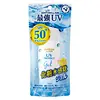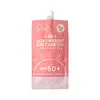What's inside
What's inside
 Key Ingredients
Key Ingredients

 Benefits
Benefits

 Concerns
Concerns

 Ingredients Side-by-side
Ingredients Side-by-side

Water
Skin ConditioningAlcohol
AntimicrobialEthylhexyl Methoxycinnamate
UV AbsorberPropylene Glycol
HumectantIsopropyl Myristate
EmollientHydrogenated Polyisobutene
EmollientEthylhexyl Triazone
UV AbsorberDiethylamino Hydroxybenzoyl Hexyl Benzoate
UV FilterStearyl Dimethicone
EmollientPhenoxyethanol
PreservativeAcrylates/C10-30 Alkyl Acrylate Crosspolymer
Emulsion StabilisingMethylparaben
PreservativePolyglyceryl-3 Methylglucose Distearate
EmulsifyingStearoyl Inulin
EmollientCarbomer
Emulsion StabilisingSodium Hydroxide
BufferingBHT
AntioxidantButylene Glycol
HumectantTocopheryl Acetate
AntioxidantEthoxydiglycol
HumectantCucumis Sativus Juice
EmollientAloe Barbadensis Leaf Juice Powder
Skin ConditioningRosa Centifolia Flower Extract
AstringentLactic Acid
BufferingGlucose
HumectantChamomilla Recutita Flower Extract
MaskingPrunus Persica Leaf Extract
EmollientLuffa Cylindrica Fruit/Leaf/Stem Extract
Skin ConditioningPerilla Ocymoides Leaf Extract
TonicTocopherol
AntioxidantBisabolol
MaskingWater, Alcohol, Ethylhexyl Methoxycinnamate, Propylene Glycol, Isopropyl Myristate, Hydrogenated Polyisobutene, Ethylhexyl Triazone, Diethylamino Hydroxybenzoyl Hexyl Benzoate, Stearyl Dimethicone, Phenoxyethanol, Acrylates/C10-30 Alkyl Acrylate Crosspolymer, Methylparaben, Polyglyceryl-3 Methylglucose Distearate, Stearoyl Inulin, Carbomer, Sodium Hydroxide, BHT, Butylene Glycol, Tocopheryl Acetate, Ethoxydiglycol, Cucumis Sativus Juice, Aloe Barbadensis Leaf Juice Powder, Rosa Centifolia Flower Extract, Lactic Acid, Glucose, Chamomilla Recutita Flower Extract, Prunus Persica Leaf Extract, Luffa Cylindrica Fruit/Leaf/Stem Extract, Perilla Ocymoides Leaf Extract, Tocopherol, Bisabolol
Water
Skin ConditioningEthylhexyl Methoxycinnamate
UV AbsorberEthylhexyl Salicylate
UV AbsorberDimethicone
EmollientDipropylene Glycol
HumectantPEG-400
Emulsion StabilisingGlycerin
HumectantPhenoxyethanol
PreservativeTitanium Dioxide
Cosmetic ColorantTriethanolamine
BufferingAcrylates/C10-30 Alkyl Acrylate Crosspolymer
Emulsion StabilisingParfum
MaskingDisodium EDTA
Butylene Glycol
HumectantSodium Acrylate/Sodium Acryloyldimethyl Taurate Copolymer
Emulsion StabilisingAloe Barbadensis Leaf Extract
EmollientIsohexadecane
EmollientCitrullus Lanatus Fruit Extract
Skin ConditioningXanthan Gum
EmulsifyingPolysorbate 80
EmulsifyingBambusa Vulgaris Leaf Extract
Skin ConditioningLonicera Caprifolium Extract
AstringentOldenlandia Diffusa Extract
Skin ConditioningSorbitan Oleate
Emulsifying1,2-Hexanediol
Skin ConditioningLimonia Acidissima Extract
Skin ConditioningYeast Extract
Skin ConditioningSodium Hyaluronate
HumectantCyclohexane
SolventEthylhexylglycerin
Skin ConditioningWater, Ethylhexyl Methoxycinnamate, Ethylhexyl Salicylate, Dimethicone, Dipropylene Glycol, PEG-400, Glycerin, Phenoxyethanol, Titanium Dioxide, Triethanolamine, Acrylates/C10-30 Alkyl Acrylate Crosspolymer, Parfum, Disodium EDTA, Butylene Glycol, Sodium Acrylate/Sodium Acryloyldimethyl Taurate Copolymer, Aloe Barbadensis Leaf Extract, Isohexadecane, Citrullus Lanatus Fruit Extract, Xanthan Gum, Polysorbate 80, Bambusa Vulgaris Leaf Extract, Lonicera Caprifolium Extract, Oldenlandia Diffusa Extract, Sorbitan Oleate, 1,2-Hexanediol, Limonia Acidissima Extract, Yeast Extract, Sodium Hyaluronate, Cyclohexane, Ethylhexylglycerin
 Reviews
Reviews

Ingredients Explained
These ingredients are found in both products.
Ingredients higher up in an ingredient list are typically present in a larger amount.
Acrylates/C10-30 Alkyl Acrylate Crosspolymer is a synthetic polymer. It is used to thicken and improve the texture of products. Due to its properties, it can prevent water and oil ingredients from separating.
Butylene Glycol (or BG) is used within cosmetic products for a few different reasons:
Overall, Butylene Glycol is a safe and well-rounded ingredient that works well with other ingredients.
Though this ingredient works well with most skin types, some people with sensitive skin may experience a reaction such as allergic rashes, closed comedones, or itchiness.
Learn more about Butylene GlycolEthylhexyl Methoxycinnamate is an organic compound that provides UVB protection. It often goes by the more common name of octinoxate. It is created from methoxycinnamic acid and 2-ethylhexanol.
Ethylhexyl Methoxycinnamate absorbs UVB rays with wavelengths between 280-320 nm. UV absorbers protect your skin by using chemical reactions to convert UV rays into heat and energy.
UVB (290-320 nm) rays emit more energy than UVA rays. They are capable of damaging DNA, causing sunburns and are thought to be linked to skin cancer.
The state of Hawaii has banned sunscreens containing octinoxate due to its potential impact on coral reefs. More research is needed to bridge gaps in this research. The European Union allows higher levels of octinoxate in sunscreens than the US and Australia.
Ethylhexyl Methoxycinnamate is oil soluble. It is not stable and may lose efficacy when exposed to sunlight.
Learn more about Ethylhexyl MethoxycinnamatePhenoxyethanol is a preservative that has germicide, antimicrobial, and aromatic properties. Studies show that phenoxyethanol can prevent microbial growth. By itself, it has a scent that is similar to that of a rose.
It's often used in formulations along with Caprylyl Glycol to preserve the shelf life of products.
Water. It's the most common cosmetic ingredient of all. You'll usually see it at the top of ingredient lists, meaning that it makes up the largest part of the product.
So why is it so popular? Water most often acts as a solvent - this means that it helps dissolve other ingredients into the formulation.
You'll also recognize water as that liquid we all need to stay alive. If you see this, drink a glass of water. Stay hydrated!
Learn more about Water